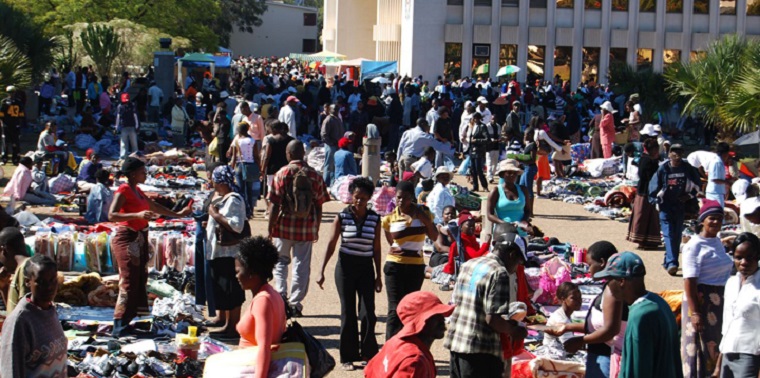
Victor Bhoroma ZIMBABWE’S informal sector is growing in leaps and bounds as the business environment continues to deteriorate. It is estimated between 85-90% of Zimbabweans are engaged in informal economic activities at a personal, household or enterprise level.
The 2022 Labour Force Survey published by the Zimbabwe National Statistics Agency (Zimstat) points that 3,3 million people are employed locally, pointing that over 2,8 million Zimbabweans derive their living from the informal sector as opposed to 495 000 in formal employment.
The informal sector is connected into the local and regional supply chains, thus creating a trading platform where millions of dollars exchange hands daily.
A 2018 study by the International Monetary Fund (IMF) discovered that 60% of the Zimbabwean economy is informal, second in the world only to Bolivia’s 62,3%.
The level of informalisation in the country is now estimated to be between 65% and 70% due to several push-and-pull factors such as high inflation, poor remuneration in the formal sector, punitive foreign exchange regulations, weak institutions and high levels of corruption, low tax morale, high levels of unemployment, overregulation, limited automation in tax collection and increase in poverty levels in the country.
It has been observed that developing countries with a large agricultural sector also tend to have high levels of informalisation as trade in agricultural commodities between producers and merchants are typically cash transactions. However, informality is also a factor of vulnerability, with millions of employees in the informal sector lacking job and social security, income consistency, health insurance, savings and living from hand to mouth. All these conditions are closely associated with poverty.
Defining the informal sector The International Labour Organisation (ILO) defines the informal sector as all economic activities by workers and economic units that are not covered or sufficiently covered by formal arrangements at law.

Formal arrangements include adherence to contracts in business transactions, applying labour regulations, social security contributions, banking proceeds, paying requisite taxes and council levies, and following legal channels on importing and exporting goods.
- Chamisa under fire over US$120K donation
- Mavhunga puts DeMbare into Chibuku quarterfinals
- Pension funds bet on Cabora Bassa oilfields
- Councils defy govt fire tender directive
Keep Reading
Therefore, those employed in the informal sector are not subject to national labour legislation, income taxation, social protection, or entitlement to certain employment benefits such as maternity leave.
The informal sector has been referred to as the grey economy, shadow economy, underground economy, parallel sector, and cash economy in some circles.
Zimbabwe’s dual economy The formal sector and the informal sector have become two distinct economies in Zimbabwe with the former vulnerable to complex tax regimes and inconsistent monetary policies while the latter has no regard for both.
The informal sector contribution to Gross Domestic Product (GDP) is estimated to be below 50%, according to national statistics. According to the World Bank, Zimbabwe’s economy grew by 5,8% to US$19,2 billion in 2021 after contracting by 6,1% in 2019 and 6,2% in 2020.
The economic instability witnessed in the past three years also triggers informalisation among small businesses. The existence of the dual economy makes it difficult for the government to control the economy through fiscal or monetary policy as the informal sector is largely cash based and fully dollarised.
African comparisons The size of the informal economy in Africa in terms of its contribution to GDP has declined from an average of 41% of total GDP in 1990 to an estimated 33% of total GDP by end of 2020.
Nigeria is the second ranked country with high informality averaging 53% of the country’s GDP, though the figure has declined from the 57% of the 1990s. Mauritius is the country with least informal economic activities which averages 18% towards national GDP.
South Africa, Algeria, Rwanda, Botswana, Namibia and Morocco are among the countries with low levels of informalisation. The countries with low levels of informalisation are also the least corrupt countries in Africa on the Transparency International Corruption Index.
Impact of policy missteps The complex tax regime, multiple tax heads to various government entities and frequent renewals are all triggers of informalisation in Zimbabwe as businesspeople find ways to cut costs.
According to the survey conducted by the Zimbabwe National Chamber of Commerce (ZNCC) in 2019, a business operating locally will have to make at least 51 payments for various tax heads for it to be considered tax compliant.
The local taxation complexity has to do with limited automation (excessive paperwork), archaic laws, payment in different currencies, need to travel to Harare or other cities to make tax contributions and the multifaceted government departments involvement.
Thus, the level of informalisation is higher in rural areas where digitalisation and formal banking channels are limited.
Equally, Zimbabwe’s monetary policy is far from being consistent. In the last 15 years, the local currency (notes, coins or electronic) has assumed at least five different names while there is no free-market price determination of foreign currency.
The central bank issues a plethora of circulars and regulations which are sometimes contradictory.
The high levels of money printing and resultant inflation leads to low confidence, loss of savings and income for households, which inflames informalisation.
Informalisation in formal businesses The past 10 years have also seen increased levels of informalisation in business operations by players in the formal sector. Corporates are finding ways to evade taxes, compensate for the disparity between the manipulated formal exchange rates and the market rate by not banking cash proceeds, buying foreign currency off the parallel market, not paying council levies, using parallel exchange rates in forward pricing, paying employees in hard currency, not filing tax returns, externalising cash, smuggling in raw materials, and falsifying imports or exports.
Poverty and informality link High levels of informalisation have a positive correlation with poverty. According to Zimstat, extreme poverty in Zimbabwe has been rising over the past three years, growing from 29% in 2018 to 34% in 2019, 49% in 2020 and 43% in 2021.
This means that approximately 2,2 million Zimbabweans have sunk into poverty since January 2018. Although poverty remains an overwhelmingly rural phenomenon, it has increased relatively faster in urban areas leading to the urbanisation of poverty.
Harare is one of the biggest contributors to poverty statistics in Sub-Saharan Africa, a situation exacerbated by the fact that most of the countries with high cases of poverty, such as South Sudan, Somalia, Madagascar and Burundi are characterised by conflict, civil wars, or unrest.
High informalisation unsustainable Zimbabwe’s informal sector bears a mark of economic resilience, however high levels of informalisation are also unsustainable for any country as it leads to limited tax mobilisation on the part of Treasury, which leads to poor public service delivery (Dilapidated Road infrastructure, power generation, health care, education, housing, water, and other amenities) and limited capacity to repay public debt (increase in arrears).
While the informal sector is growing, it cannot be excluded from consuming public services despite not contributing to tax payments. Over and above the negative aspects mentioned in the introduction, high levels of informalisation lead to a limited credit market and savings growth in the economy, limited growth in the financial and insurance sector (decline in Banking sector lending and geographical presence).
Informalisation also nurtures and aids corruption, and criminal activities in the economy. Thus, levels of information must be managed to below 40% of the economy to ensure sustainable economic growth.
Zimbabwe’s public debt is estimated to grow to US$18,37 billion by December 2022 (declared figures only), with external debt arrears contributing US$13 billion. Based on current tax revenue figures, Harare has no capacity to repay its external debt despite guarantees of support from the African Development Bank (AfDB).
There is an urgent need to remove barriers to formalisation through simplifying the tax registration process and providing incentives to fiscalisation by making the cost of fiscalisation tax deductible or partnering commercial banks to spread the cost of fiscalisation on the part of Zimra.
This means that tax payments and filing tax returns should be done efficiently online without visiting the tax agency. For the few tax compliant businesses, the tax agency must process tax rebates efficiently and give holidays where it is necessary.
The government would need to chart flexible labour laws that make it easy for businesses to retrench through short term notices and employees to quit through short term notices.
The new labour laws which compel employers to accord permanent employment status after consecutive contracts push employers to retrench repeat contract employees while restricting their ability to hire short term labour.
For sustainable economic growth, supply side incentives to re-industrialise the economy and diversify to value addition and beneficiation, and services are key to formalising the local economy.
As the population grows and economic instability persists, deliberate policies must implemented to contain informalisation and eliminate all barriers to formalisation.
- Bhoroma is an economic analyst. He holds an MBA from the University of Zimbabwe (UZ). — [email protected] or Twitter @VictorBhoroma1.











